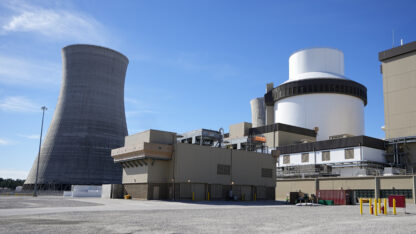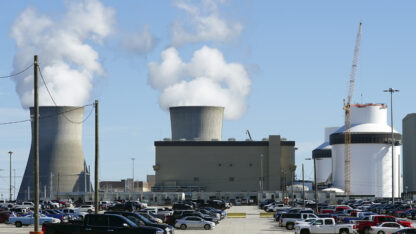New nuclear reactor enters service, driving Georgians' power bills higher

This coverage is made possible through a partnership with WABE and Grist, a nonprofit, independent media organization dedicated to telling stories of climate solutions and a just future.
The first new nuclear reactor at Plant Vogtle is now in service – which means bills are going up again for Georgia Power customers. A charge of about $5.46 for the typical residential customer will appear on power bills in August, according to the Southern Environmental Law Center.
It is the third bill increase this year, with more on the way.
“The Plant Vogtle 3 & 4 nuclear expansion is another incredible example of how Georgia Power is building a reliable and resilient energy future for our state,” said Georgia Power CEO Kim Greene in a statement announcing Unit 3 had entered service.
“It is important that we make these kinds of long-term investments and see them through so we can continue providing clean, safe, reliable and affordable energy to our 2.7 million customers.”
Georgia Power customers have already been paying a monthly charge for the cost of financing the Plant Vogtle construction, amounting to nearly $100 per customer per year for more than a decade, according to recent testimony before the Public Service Commission.
The new amount is the first of two already-approved increases related to the new reactors, with another price hike coming when the second new reactor goes online.
Those charges account for just a fraction of the project’s total price tag of more than $30 billion.
“It’s a bit scary to think about how big these numbers are and what it might mean for everyday citizens who are struggling to pay their bills, and who an additional $5, an additional $10 a month is very significant,” said Bob Sherrier, a staff attorney with SELC.
The costs don’t fall entirely to Georgia Power and its customers. The state’s largest utility owns the largest share of the new Plant Vogtle reactors alongside Oglethorpe Power, which provides electricity to 38 electric membership cooperatives; MEAG Power, which supplies cities with electricity and Dalton Utilities.
The rate impact for customers of the other co-owners will vary. Oglethorpe Power, for instance, offers different voluntary programs that EMCs can choose from to incorporate Vogtle construction costs into their rates, according to a spokesperson. Those decisions are up to each EMC and municipality.
What Georgia Power customers pay is up to the state Public Service Commission, which will hold prudency hearings to determine how much of the costs customers will have to bear.
Advocacy groups like SELC are gearing up for those hearings.
“We do hope that prudency review is a full exploration of why it was so much more expensive than we were told,” Sherrier said.
The total cost of building the new reactors has more than doubled over the course of construction. Unit 3 has come online more than seven years past the originally announced date of 2016, and the price tag has climbed with the delays.
The Public Service Commission is tasked with determining what costs are reasonable and prudent; Georgia Power is only allowed to pass costs deemed prudent on to customers. That process, likely to be contentious and complicated, will begin once Unit 4 comes online, currently projected to happen late this year or early next year.







